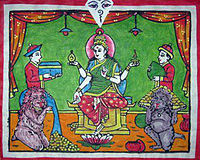Khyah (legendary creature)


Khyāh (Nepal Bhasa:𑐏𑑂𑐫𑐵𑑅) (alternative spellings Khyā, Khyāk) (ख्याक) is a mythical humanoid creature in Newari folklore. It is depicted as a fat, hairy and short ape-like creature.
Khyahs appear in children's stories popular in Newar society. A friendly Khyah fills the home with goodness while bad ones bring trouble. A white Khyah is believed to bring good luck while a black one can create problems. Encountering a Khyah can make one ill.[1] Khyahs are said to tickle their victims to death.
In Newar culture, Khyahs attend to Lakshmi, the goddess of wealth, and pictures of the deity show them guarding overflowing bags of coins.[2][3] Household Khyahs usually dwell in the attic and dark storerooms. They are said to fear electric lighting.[4]
The antithesis of the Khyah is the Kawanchā, a skeleton.[5][6] Khyahs and Kawanchas appear as supporting characters in sacred dance dramas of the Newars.[7][8] Images of Khyahs and Kawanchas are also placed at temples as guardians of the shrine.
Khyah dance
During the
Types of Khyah
- Bārāy Khyāh (बाराय् ख्याः) appears in rooms where girls are kept in seclusion during their rite of passage.[9]
- Bhakun Gwārā Khyāh (भकुं ग्वारा ख्याः), literally football, rolls on the ground to move around.[10]
- Dhāpalān Khyāh (धापलां ख्याः) is a very hairy Khyah.
- Lanpan Khyāh (लँपं ख्याः) blocks people's way on dark streets.
- Bun Khyāh : is the one who lives at crop field
In popular culture
This is a traditional children's song in Newar about Dhāpalān Khyāh used in a singing game:
|
|
|
References
- ISBN 8173031770, 9788173031779. Page 47.
- ^ Shrestha, Bal Gopal (July 2006). "The Svanti Festival: Victory over Death and the Renewal of the Ritual Cycle in Nepal". Contributions to Nepalese Studies. Center for Nepal and Asian Studies, Tribbuvan University. Retrieved 22 July 2012. Page 209.
- ^ Beer, Robert (2012). "Tibetan Buddhist & Newar Tantri Art". Retrieved 20 July 2012.
- ISBN 9057890984, 9789057890987. Page 266.
- ^ Koizumi, Fumio (1983). Dance and music in South Asian drama: Chhau, Mahākālī pyākhan and Yakshagāna. Academia Music.
- ISBN 8173042462, 9788173042461. Page 104.
- ^ "Khyak dance". Nepalese Dances. Retrieved 20 July 2012.
- ISBN 9057890984, 9789057890987. Page 57.
- ISBN 3447057521, 9783447057523. Page 174.
- ISBN 8173031770, 9788173031779. Page 47.
